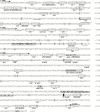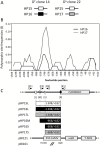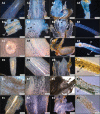Differential fine-tuning of gene expression regulation in coffee leaves by CcDREB1D promoter haplotypes under water deficit
- PMID: 28830103
- PMCID: PMC5853422
- DOI: 10.1093/jxb/erx166
Differential fine-tuning of gene expression regulation in coffee leaves by CcDREB1D promoter haplotypes under water deficit
Abstract
Despite the importance of the DREB1D gene (also known as CBF4) in plant responses to water deficit and cold stress, studies analysing its regulation by transgenic approaches are lacking. In the current work, a functional study of three CcDREB1D promoter haplotypes (named HP15, HP16 and HP17) isolated from drought-tolerant and drought-sensitive clones of Coffea canephora was carried out in plants of C. arabica stably transformed by Agrobacterium tumefaciens by analysing their ability to regulate the expression of the uidA reporter gene in response to water deficit mimicked by polyethylene glycol (-2.0 MPa) and low relative humidity treatments. A deletion analysis of their corresponding 5'-upstream regions revealed increased specificity of β-glucuronidase activity in the polyethylene glycol and low relative humidity treatments, with high expression in leaf mesophyll and guard cells in full-length constructs. RT-qPCR assays also revealed that the HP16 haplotype (specific to clone tolerant to water deficit) had stronger and earlier activity compared with the HP15 and HP17 haplotypes. As most of the cis-regulatory elements involved in ABA-dependent and -independent networks, tissue specificity and light regulation are common to these haplotypes, we propose that their organization, as well as the nucleic acid polymorphisms present outside these boxes, may play a role in modulating activities of DREB1D promoters in guard cells.
Keywords: Coffee; DREB1D gene; genetic transformation; promoter haplotypes; uidA reporter gene; water deficit.
© The Author 2017. Published by Oxford University Press on behalf of the Society for Experimental Biology.
Figures






References
-
- Agarwal M, Hao Y, Kapoor A, Dong CH, Fujii H, Zheng X, Zhu JK. 2006a. A R2R3 type MYB transcription factor is involved in the cold regulation of CBF genes and in acquired freezing tolerance. The Journal of Biological Chemistry 281, 37636–37645. - PubMed
-
- Agarwal PK, Agarwal P, Reddy MK, Sopory SK. 2006b. Role of DREB transcription factors in abiotic and biotic stress tolerance in plants. Plant Cell Reports 25, 1263–1274. - PubMed
-
- Avelino J, Willocquet L, Savary S. 2004. Effects of crop management patterns on coffee rust epidemics. Plant Pathology 53, 541–547.
-
- Blum A. 2014. Genomics for drought resistance—getting down to earth. Functional Plant Biology 41, 1191–1198. - PubMed
MeSH terms
Substances
LinkOut - more resources
Full Text Sources
Other Literature Sources
Research Materials

